Western Blot HRP Substrate(IC-5008)

Western Blot HRP Substrate (IC-5008-100)
Solution A (Luminol Solution) 50 mL 1 bottle
Solution B (Peroxide Solution) 50 mL 1 bottle
3.To ensure complete removal of antibodies, incubate the membrane with HRP working substrate and expose against X-ray film for 5 minutes. No signal should be observed for complete stripping.
Troubleshooting
Problem
Possible cause
Remedy
No signal or weak signal
Poor transfer efficiency
Optimize the membrane transferring procedure
Insufficient antigen
Increase the amount of loaded antigen
Make sure the blot have been store correctly to avoid the degradation of target protein
The concentration of primary and secondary antibody is too low
Increase the concentration of the primary and/or the secondary antibody
Inappropriate storage/preparation of the ECL detection reagents
Use HRP or HRP conjugates to check the applicability of ECL reagents
Too short exposure time
Extend exposure time
Excessive signal
Antigen or antibody excess
Reduce the amount of loaded antigen
Dilute the primary antibody and/or the secondary antibody
Antigen or antibody excess
Optimize the condition by reducing the amount of antigen, or the concentration of the primary antibody and/or secondary antibody. Initially, reduce the secondary antibody to 20% of the original usage
Inappropriate blocking
Try different blocking substrate such as gelatin, casein, skim milk or casein
High Background
Inadequate washing
Increase the concentration of Tween-20 in washing solution
Increase the washing steps between the hybridization procedures
Extend washing time
Overexposure to film
Shorten the exposure time
Order Information
Cat./REF.
Size
Price($£©
Price(€)
Price(£¤/CNY£©
Price(£¤/JYP£©
IC-5008
100ml
$74.50
€ 89.40
£¤745.00
£¤14,825.50
IC-5008
200ml
$120.00
€ 144.00
£¤1,200.00
£¤23,880.00
IC-5008
500ml
$250.00
€ 300.00
£¤2,500.00
£¤49,750.00


